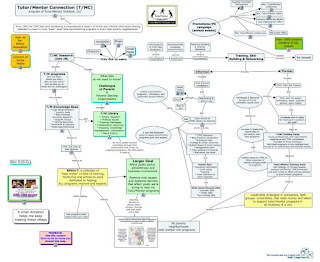I'm going to show four graphics from my collection in this article. I hope you'll take time to dig through the links.
1) This graphic shows three time frames when we can connect with kids and the number of years we need to be doing this.
It shows a group of kids and an adult volunteer who were part of a tutor/mentor program I led in Chicago in the 1990s and myself with one of those kids in 2010 when she came back as a guest speaker at our end-of-year dinner. I'm connected to almost all of these former students and the volunteer on Facebook and now see them posting stories of their own kids finishing high school and going to college. That's the generational impact possible from well-organized volunteer-based tutor/mentor programs who build and sustain long-term connections with kids.
I focus on the after-five PM timeframe because in big cities like Chicago, that's when workplace volunteers are more able to meet with kids in community locations on a weekly, on-going basis.
2) This next graphic includes a Birth-to-Work arrow that I've used in many past articles and in a variety of graphics. I show many in this Pinterest collection.
This graphic includes a map of Chicago, showing high poverty areas were kids need mentoring-based support during school and non-school hours, from pre-school through high school and beyond. Click on the image to enlarge and look at some of the types of activities that could be made available to kids at different age levels. If you were to stand the arrow on end, like a tall building, it would emphasize how these supports are needed consistently for 10-20 years, in every neighborhood with high levels of poverty, meaning too few people to model the wide range of career choices kids have, and to help them through school and into those opportunities. Volunteers in organized tutor/mentor programs can help make some of these learning opportunities available, even if they are not available in local schools.
I started building a library in the 1970s to support the volunteers in the tutor/mentor program I led at the Montgomery Ward Headquarters in Chicago. When we created the Tutor/Mentor Connection in 1993 we systematically expanded that library and made it available to program leaders throughout Chicago (before the internet) and then to volunteers, donors, policy-makers and program leaders throughout the world (starting in 1998, with the Internet).
3) This concept map shows how we created events throughout the year to draw users to the information, and how we hoped the information would be used.
Access the library at this link.
I started reaching out to leaders of other tutor/mentor programs in Chicago in 1974 and continued through the 1980s. I was looking for ideas to support my own efforts. This began to turn into a networking effort where each program was learning from the others.
From my retail advertising jobs I knew how we created weekly advertising intended to draw customers to our 400 stores in 40 states, and how other corporate office teams worked to help each store have the staff and merchandise needed to serve those customers and keep them coming back.
I applied this in my leadership of a single program, and applied this strategy via the Tutor/Mentor Connection (1993-present) and Tutor/Mentor Institute, LLC (2011-present). Since I did not have many dollars for advertising I created a strategy of quarterly annual events that would draw media attention and focused on ways business, universities and others could use their own human capital and dollars to help programs grow in different places.
Here's a video, created in 2015 by an intern from South Korea, to guide people through this concept map. It is an example of how anyone reading my articles can create and share their own interpretation.
Unfortunately, the problems that we were addressing in the 1970s are still present as we move through 2022. Thus, the work I've been doing needs to continue.
I just turned 75 so it becomes more and more important that a university or institution reach out and take ownership of my archives, blogs, websites, etc. Student, faculty and alumni talent can do much more than I to update, analyze and share the information and draw attention and resources to area youth programs.
They can rebuild the sites that are now only archives and innovate new efforts to build public will and draw attention through the maps to EVERY neighborhood that needs Birth-to-Work support for its kids. Reach out to me if you're interested in taking this role, or helping me find someone who will.











No comments:
Post a Comment